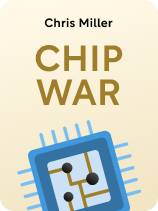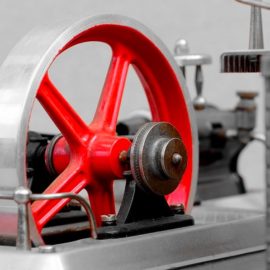

This article is an excerpt from the Shortform book guide to "Chip War" by Chris Miller. Shortform has the world's best summaries and analyses of books you should be reading.
Like this article? Sign up for a free trial here.
What do we know about the TSMC business model? How does TSMC make the most of economies of scale in production?
The TSMC business model is also called the foundry model, and it centers around optimizing the company for manufacturing while outsourcing design. Understanding the benefits of their model tells us a lot about the advantages of economies of scale and specialization.
Read on to discover what makes TSMC’s business model innovative and successful.
The Origins of TSMC and the Foundry Model
In this article, we’ll discuss the rise of Taiwan Semiconductor Manufacturing Company (TSMC) and the TSMC business model, from the Taiwanese chip industry beginning in the 1980s to the resulting shift to the foundry model for chip manufacturing. Then, we will discuss the corresponding shift to the “fabless” model for chip design, and the decentralization and globalization of the chip supply chain.
Morris Chang Founds TSMC
In 1985, Chinese-born entrepreneur Morris Chang left Texas Instruments (TI) after being passed over for the CEO role. Spurned by the company to which he’d devoted his career, Chang decided to seize a different opportunity—to make Taiwan the new epicenter of the chip industry and place himself at its head. In 1987, he founded TSMC, a public-private partnership that would become the dominant global player in chip manufacturing.
Fortunately for Chang’s ambitions, the Taiwanese government was eager to develop a domestic semiconductor industry to reduce its reliance on foreign technology and create a strategic economic advantage. Thus, they were enthusiastic about providing Chang’s initiative with significant support through financial incentives, access to resources, regulatory assistance, and tax incentives. Indeed, this backing was crucial for establishing the necessary infrastructure and acquiring advanced manufacturing equipment for large-scale chip production.
| TSMC Aims to Maintain Dominance by Globalizing Production As its domestic semiconductor industry has grown, TSMC has maintained a strong desire to safeguard its competitive edge. One way of doing this is by investing in chip facilities in the US, which would help the company diversify its production locations and enhance supply chain resilience. This strategy has been a flashpoint of controversy in Taiwan. In 2022, the state-backed firm announced plans to invest $40 billion in a new advanced chip manufacturing facility in Arizona. However, Taiwan’s economy and national security are closely tied to the semiconductor sector, and TSMC’s investments in the US have sparked concerns in Taiwan about technology and intellectual property leakage to the US and possible future dependency on US facilities. |
The Foundry Model
What truly set TSMC apart from other chip companies was its pioneering role in spearheading what’s known as the foundry model.
Instead of designing their own chips, TSMC only manufactured chips designed by other companies—they were a manufacturing workshop. This offered distinct business advantages for TSMC through economies of scale and the opportunity to hone its production capabilities.
The Advantage of Economies of Scale
By mass producing chips for multiple customers, TSMC could achieve cost efficiencies through economies of scale. A small chip manufacturer faces relatively high costs to manufacture each chip—they have to set up and run their manufacturing equipment, pay for labor, and cover other fixed costs, with those costs spread out over a small number of chips. Thus, if the small manufacturer spends $100,000 on those startup costs but produces only 1,000 chips, their cost-per-chip is $1,000. But a large-scale mass producer like TSMC might produce 10 million chips, dropping their fixed costs down to $0.01 per chip.
TSMC’s Production Edge
Moreover, by focusing relentlessly on production, TSMC was able to optimize its manufacturing processes, invest in new research and development, and purchase cutting-edge lithography equipment at scale by buying in bulk. All of this made its manufacturing processes more efficient—leading to faster production times and ever-lower labor costs per chip.
(Shortform note: Beyond bulk buying, TSMC’s scale affords it other advantages that contribute to its production edge. In particular, TSMC’s ability to stockpile critical materials, such as silicon wafers, during periods of high demand or shortages, enhances its supply chain resilience. This helps ensure a steady production flow even when the company is faced with external supply disruptions.)
TSMC’s Dominance
By achieving scale like this, TSMC was able to produce chips at a price that its competitors couldn’t beat.
TSMC secured a hammerlock on the manufacturing process for key electronics like iPhones and other smartphones—achieving this position after Intel famously turned down Steve Jobs for the iPhone contract, not seeing the potential of the smartphone market. With major customers like Apple, TSMC held 50% of the global chip foundry market by 2015.
(Shortform note: In order to maintain its globally dominant position in the chip industry, TSMC has had to strategically expand production into other regions. However, TSMC is committed to preserving its Taiwanese identity. The company’s origins and headquarters are in Taiwan, where it has a significant presence and continues to play a vital role in the country’s economy. The company’s expansion into other countries, such as the United States and Japan, is driven by the need to diversify its production and reduce geopolitical risks but not to sever its ties with Taiwan. The company’s presence in Taiwan remains integral to its identity and the broader semiconductor landscape, despite its strategic expansion to other regions.)
TSMC’s success also heralded a revolution in chip design, as the chip design industry shifted toward what’s become known as the “fabless” model—in which the company focuses only on chip design rather than design and manufacturing.

———End of Preview———
Like what you just read? Read the rest of the world's best book summary and analysis of Chris Miller's "Chip War" at Shortform.
Here's what you'll find in our full Chip War summary:
- The history and rise of the semiconductor industry in the US and abroad
- How national security became intertwined in the chip industry
- How a spurned TI employee grew the chip industry in Taiwan






